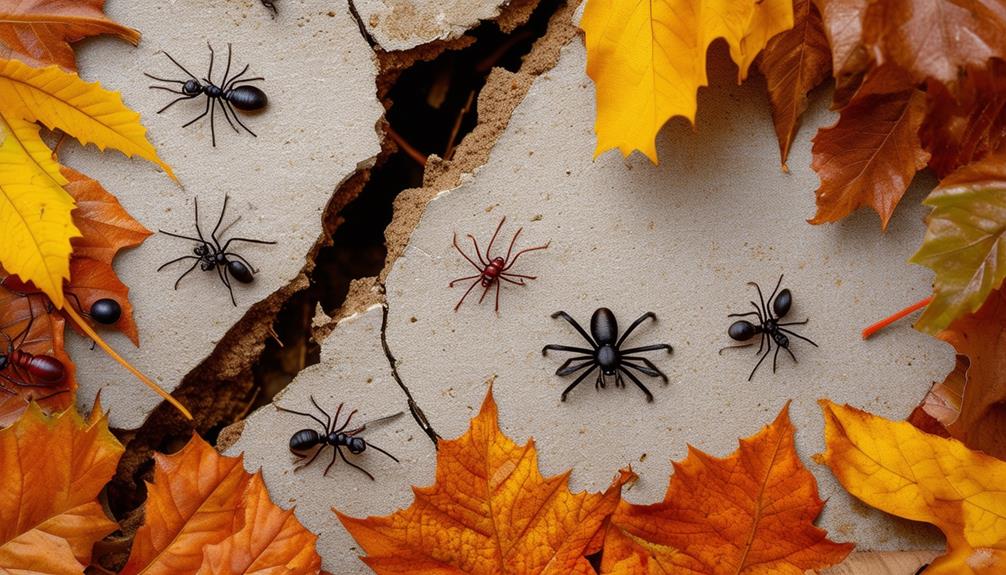When it comes to urban environments, the presence of cockroaches can pose serious challenges. From health concerns to property damage, these resilient pests can quickly become a nuisance. But fear not, as there are effective strategies you can implement to keep these unwanted visitors at bay. By exploring innovative techniques and proactive approaches, you’ll discover how to create a more cockroach-free environment in your urban area. Stay tuned to uncover the key steps and insights that can make a significant difference in preventing cockroach infestations for good.
Key Takeaways
- Maintain high sanitation standards to eliminate food and water sources.
- Seal entry points and cracks to prevent cockroach access to buildings.
- Implement integrated pest management combining traps, baits, and insecticides.
- Educate residents on cockroach prevention through community outreach programs.
- Collaborate with stakeholders for diverse control strategies and effective urban management.
Importance of Urban Cockroach Prevention
In urban environments, the prevention of cockroach infestations is of paramount importance due to the dense population and close proximity of structures. Cockroach control in urban areas is challenging but vital for maintaining public health standards.
Implementing effective prevention measures is essential to curb the spread of infestations between buildings and apartments. Proper sanitation practices, such as regular cleaning and waste disposal, play a key role in eliminating food and water sources that attract cockroaches. Sealing entry points, such as cracks and crevices in walls and floors, helps prevent these pests from gaining access to buildings.
Urban areas offer cockroaches numerous hiding spots, making it imperative to adopt integrated pest management strategies that combine various control tactics. By addressing food and water sources, sealing entry points, and employing integrated pest management techniques, urban dwellers can significantly reduce the risk of cockroach infestations and maintain a healthier living environment.
Common Cockroach Species in Urban Areas
Among the prevalent cockroach species inhabiting urban areas are the German cockroach and the Oriental cockroach, both known for their distinct characteristics and adaptability to urban environments. German cockroaches, globally distributed, are identifiable by the two dark stripes on their thorax, while Oriental cockroaches, larger and dark brown, are commonly found in urban settings.
These species pose significant challenges in multi-family housing units due to their rapid reproduction rates and ability to thrive in various conditions. Understanding the behavior and biology of German and Oriental cockroaches is essential for effective management strategies in urban areas. By recognizing the differences between these species and their preferences for nesting and feeding, pest control measures can be tailored to target the specific vulnerabilities of each type.
Stay informed about the common cockroach species in your area to implement proactive measures and prevent infestations.
Cockroach Life Cycle and Behavior
Understanding the intricacies of the cockroach life cycle and behavior is fundamental for developing effective pest control strategies. Cockroaches progress through three main life stages: egg, nymph, and adult. Eggs are carried in egg capsules by adult cockroaches, and it takes 40 to 125 days for an egg to mature into an adult.
Nymphs, which are immature cockroaches, undergo multiple molts before reaching adulthood. Each adult female cockroach has the potential to produce 4 to 8 egg capsules during her lifetime, contributing greatly to population growth.
Effective Pest Management Strategies
To effectively manage cockroach infestations, it’s vital to conduct thorough inspections for signs of infestation within urban areas.
Implementing strict sanitation practices to eliminate food and water sources for roaches is essential in controlling their population.
Utilizing various pest control methods, such as traps and targeted insecticides, can aid in eradicating existing infestations and preventing future ones.
Inspection for Infestations
Regular inspections are crucial for effectively managing cockroach infestations in urban areas. By conducting thorough and consistent inspections, you can identify cockroaches and their likely habitats early on, allowing for prompt treatment measures.
Inspections help you detect conditions that promote infestations, such as the availability of food and water sources, entry points like cracks and holes, and the presence of bait stations. Professional inspections are particularly recommended for severe infestations in urban settings to guarantee effective Pest Management (IPM) strategies are implemented.
Through inspection, you can determine the extent of the infestation and tailor control methods accordingly, ultimately aiding in the prevention of widespread cockroach issues in urban areas.
Sanitation Practices
Sanitation practices indoors and outdoors are essential for effectively managing cockroach populations in urban areas. To prevent cockroach infestations, it is important to maintain cleanliness and limit access to food and water sources. Cleaning up spills promptly, disposing of kitchen waste in secure containers, and ensuring no unwashed dishes are left overnight are vital steps to reduce the number of cockroaches. Regularly cleaning areas like counters, sinks, tables, and floors not only helps in monitoring for cockroach presence but also eliminates potential food sources that attract these pests. By following proper sanitation practices, you can greatly decrease the likelihood of cockroach infestations in your surroundings.
| Sanitation Practice | Importance |
|---|---|
| Cleaning up spills promptly | Limits access to food and water sources |
| Proper waste disposal | Prevents infestations in urban areas |
| Washing dishes and utensils promptly | Reduces the number of cockroaches |
| Regular cleaning of surfaces | Eliminates potential food sources for cockroaches |
| Securing kitchen waste containers | Deters cockroaches from accessing food sources |
Pest Control Methods
Effective pest management strategies for controlling cockroach populations involve implementing Integrated Pest Management (IPM) tactics that combine public education, trap usage, and targeted insecticides. To effectively control cockroach infestations, consider the following:
- Public Education: Informing residents about cockroach behavior and prevention methods.
- Trap Usage: Deploying traps strategically in areas prone to cockroach activity.
- Targeted Insecticides: Using insecticides specifically formulated for cockroach control.
- Gel Baits: Implementing gel baits as an alternative method to deter cockroaches and prevent resistance evolution.
Environmental Factors Affecting Infestations
In urban environments, the presence of high humidity levels greatly influences the likelihood of cockroach infestations. Cockroaches, such as the German and American species, thrive in warm and humid conditions, making cities with high moisture levels ideal habitats for these pests. Hiding places are abundant in urban settings, with cracks, crevices, and voids in buildings providing perfect shelters for cockroaches to breed and multiply. Additionally, water leaks in urban infrastructures attract cockroaches as they seek out moisture for survival.
Improper sanitation practices in urban areas play a significant role in attracting and sustaining cockroach populations. Trash accumulation in densely populated regions serves as a plentiful food source and breeding ground for these pests. Moreover, urban landscapes with numerous food sources, such as restaurants and food markets, create environments where cockroaches can easily find sustenance and rapidly reproduce. Understanding these environmental factors is essential in implementing effective strategies to prevent and control cockroach infestations in urban areas.
Community Engagement for Control Measures
Engaging the community in control measures enhances the effectiveness of preventing and managing cockroach infestations in urban areas. Community involvement plays a vital role in implementing sustainable control strategies. Here are key points to keep in mind:
- Shared Responsibility: When residents actively participate in control measures, it fosters a sense of shared responsibility, leading to a more thorough approach to tackling infestations.
- Awareness and Education: Community engagement increases awareness levels, ensuring that individuals are well-informed about preventive measures and early detection techniques.
- Collaborative Efforts: Working together with stakeholders allows for the implementation of diverse control strategies, which can have a significant impact on long-term success in controlling cockroach populations.
- Supportive Environment: Establishing a supportive environment through community engagement creates the foundation for sustainable cockroach control in urban settings. Encouraging cooperation and involvement from all members can lead to more effective and lasting results in managing infestations.
Resources for Urban Cockroach Control
Within urban environments, accessing a variety of resources is essential for effectively controlling cockroach populations. One valuable resource is the Integrated Pest Management (IPM) approach, which combines various strategies to reduce cockroach infestations.
Inside houses, boric acid is a commonly recommended tool for cockroach control, as it’s effective in targeting these pests while posing minimal risks to humans and pets. Educational programs play a vital role in equipping urban residents with the knowledge and skills needed to prevent cockroach infestations.
Local pest control companies and municipal health departments are key resources for urban dwellers seeking professional assistance in managing cockroach problems. Online platforms like pest control websites and forums offer practical tips and advice for urban cockroach prevention.
Additionally, community outreach programs provide access to educational materials, such as pamphlets and brochures, that offer guidance on effective cockroach control measures. By utilizing these diverse resources, urban residents can take proactive steps towards keeping cockroach populations in check.
Frequently Asked Questions
What Keeps Roaches Away Permanently?
To keep roaches away permanently, you need a combination of natural remedies, exclusion methods, hygiene practices, and DIY solutions. Implementing these strategies, along with professional treatments when necessary, will create barriers that deter roaches effectively.
How Do You Keep Roaches Away if Neighbors Have Them?
To keep roaches away when neighbors have them, start by communicating with them about pest control. Regularly clean your space, seal cracks, and consider professional extermination or home remedies. Use essential oils or traps, try DIY solutions, and seek professional advice.
What Is the Most Effective Cockroach Prevention?
To prevent cockroach infestations effectively, you need to focus on holistic repellents, proper sanitation, pest control, sealing cracks, and regular maintenance. These strategies form a complete approach to safeguard your living space.
Are Roaches More Common in Urban Areas?
In urban environments, roach populations tend to thrive due to abundant food and shelter. Factors like high density and shared spaces facilitate infestations. Pest control and sanitation play essential roles in managing infestation risks. Various prevention methods can help control roach populations.





